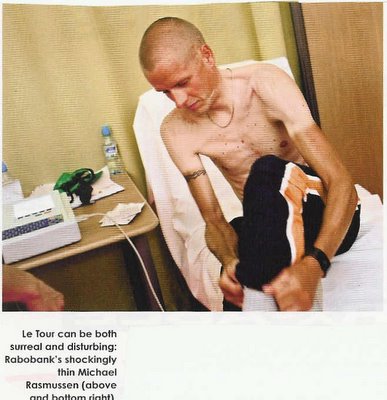A sequel to the Passion Burning post. While the original dwelled on losing weight for health, this focuses on losing weight for performance.
From a forum:

A picture of Michael Rasmussen before the last Tour de France. Is he lean, or is he lean? Weight-to-power ratio is everything when climbing. They even compromise upper body strength to keep those pounds off.
Fellow riders dubbed Rasmussen, "Rooster Cogturn," for his skinny frame (132 lb / 60 kg), while respecting his ability to turn a mean crank.
Seven-time Tour de France winner, Lance Armstrong, doesn't look too different either.
They may look unhealthy, but they are actually in the pink of health. Their resting heart rates (HRrest) are easily less than half of the typical office worker's. Lance Armstrong's resting heart rate, for example, is 32 beats a minute (bpm). Greg LeMond was once almost sent to cardiac intensive care after a routine check up because the doctor didn't realize that a resting heart rate of 30 beats per minute is considered relatively normal for a Tour de France cyclist. Miguel Indurain's heart is a statistical anomaly even in this class of super-athletes: his resting heart rate is an unbelievable 28 bpm, and it recovers from 160 bpm back to 60 bpm in 30 seconds. This may explain why, in spite of his massive 6' 2" (187 cm), 176 lbs (80 kg) frame, Indurain soundly beat lighter riders in the mountains during his reign.
For a sense of perspective, an average individual's resting heart rate is 70 to 80 beats per minute.
What does that mean?
It means that when the typical office worker, Joe Blow, is huffing, gasping, turning purple, dizzy and about to fall off his bicycle to puke his guts out struggling up a 4000 ft (1219 m) mountain pass, Rasmussen, Armstrong, LeMond and Indurain will still be chatting, their heart rates barely registering above 90 beats per minute.
Furthermore, since an individual's theoretical maximum heart rate (HRmax) is approximated by the formula,
HRmax = 220 - age
this means that an individual with a lower resting heart rate is capable of generating a higher power output. This is because the fitter individual has a higher Heart Rate Reserve (HRR):
HRR = HRmax - HRrest
There is also another benefit of lowering one's resting heart rate: since the "Fat Burning Zone" is around 60 to 75% of one's maximum heart rate, this means that a cyclist with a lower resting heart rate can actually plan to burn fat instead of carbohydrates and still maintain a reasonable speed.
Also, as fat possesses a higher concentration of energy compared to carbohydrates (fat contains 9 calories per gram--more than twice the number of calories in protein (4) or carbohydrates (4)), this means one can carry less food along, and refuel less often. While not very useful in regular racing (no one rides at 60 to 75% max. heart rate in races), this is very valuable information for endurance racing or long distance touring. There are actually energy bars made with a lot of fat for this purpose.
 930 calories of fat versus 930 calories of carbohydrates.
930 calories of fat versus 930 calories of carbohydrates.When I run out of carbs, I lower my intensity and burn fat instead. It is extremely useful. Think of it as a reserve tank. Upon weighing myself 48 hours after the completion of the Livermore-to-Santa Clara-via-Mount-Hamilton ride, I discovered that I lost 2 lbs (~0.9 kg) of body fat. This was confirmed by the body fat percentage meter.
Comments:
dennzio:
I normally weigh 160 - 165 lbs (72.7 - 75 kg) during racing season, but two years ago I got down to 148 lbs (67 kg) and climbed like my ass was on fire. I felt pretty damn good as well. I'm 5' 10" (178 cm).
-ben:
I am 6' 2" (~187 cm) and fluctuate between 148 - 154 lbs (67 - 70 kg). I go ape shit when I put on 2 lbs (~0.9 kg). 909 grams is almost 1 full water bottle's worth of weight. I.e. 1 liter = 1 kg. It feels like you have an under-inflated tire back there or something. I was once in the body building craze and got myself up to 185 lbs (84 kg). Sure, chicks checked me out more often, and guys gave me a wider berth, but I was constantly getting passed on my favorite climbs. Once, I even had this 64-year-old man pass me on Montebello Road (a 2600 feet climb over 5.2 miles), going "On yer left, sonny!" Ugh! That was it, and so here I am :p
No comments:
Post a Comment